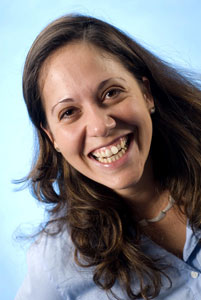Claudia Marcelloni
27 July 2009 | By

Most people at CERN know Claudia Marcelloni as the ATLAS photographer and the exquisite eye behind the ATLAS book, Exploring the Mystery of Matter. But to Claudia, photography is just one tool that she could use to practice her passion: the creative communication of ideas.
Claudia traces the first sparks of this life-long drive to communicate back to her childhood in São Paulo, Brazil. Social classes were very well defined, the economy was unstable, and people were acutely aware of where they ‘belonged’. Growing up in a middle-class family herself, she loved the fact that she was able to “have access to [the] different universes” of her neighbours – on one side a large, poor, illiterate family, and on the other a wealthy, successful, upper-class family of doctors.
“I always appreciated being capable of going to play in the dirty back yard with the poor neighbours, make fire, play with the animals, and then go to the other neighbours and play the latest videogames,” she remembers.
Her innate adaptability stood her in good stead when she finished studying communications, aged 22. Realising that a lot of the jobs she was looking at required fluent English, she decided to immerse herself in the language by taking three months of English classes in Australia. “I didn’t want to deal with cold, which left only California and Australia,” she jokes.
Within two weeks of arriving, she realised that three months wouldn’t be long enough to learn English to the level she required, so, in another bold move, she enrolled for a two-year communications course.
“It’s the hardest thing I’ve ever done, moving to a country where I didn’t speak the language, I knew nobody, and I had very little money,” she recalls. But she soon settled in, and started to make the most of her new surroundings: “Rock climbing, scuba diving, sky diving. I did all of it.”
The contrast to São Paulo’s “endless ocean of buildings” was stark. “It was all WILD, you know?!” says Claudia, wide eyed. “I was living in the North Beach area of Sydney, and had to take a ferry to get downtown. Many times I saw whales or sharks. It was just amazing. It’s when I really fulfilled that part of me that needs to be outside.”
Following her course, Claudia’s newly acquired taste for adventure led her to Nepal, alone, where she followed a 21-day hike to the Annapurna base-camp. After years of pushing herself career-wise, this period of time that she spent living a ‘survival’ existence – “I only cared about where I was going to eat and where I was going to sleep” – had a profound effect on her. “It was my first real experience of being present … I understood – you’re only a human being.”
It was in these meditative moments that Claudia took her first photographs. “I took pictures of every step and came back with so many rolls of film, I didn’t have the money to develop them all!” she laughs. When her photographer/graphic designer roommate back in Australia saw her pictures, he was impressed. “He told me I’d made a lot of amateur mistakes, but that I had a really interesting eye, especially for the people.”
With that encouragement, Claudia signed up for six months of photography classes in Sydney, before moving to California to study design and photography for three years at Berkeley. It was here, through a shared love of amateur filmmaking, that she met her husband, ATLAS Pixel engineer Neal Hartman.
When the couple moved to Switzerland, it was ATLAS Outreach Coordinator Michael Barnett who first spotted Claudia’s talents, commissioning her to do a series of 120 portraits of ATLAS collaborators. “I asked them who they were, what were their childhood dreams,” remembers Claudia, who sees her portraits as a dialogue between her and her subject. From here, she went on to work for the CERN photo service and of course, to produce the aforementioned ATLAS book.
Since the start of this year, Claudia has moved to work full-time with the ATLAS Outreach group, helping with their activities and coming up with novel and creative ways of introducing ATLAS to a broader public.
As the collaboration leaves the construction phase behind and begins to look towards physics, so too does Claudia. “Physics is a very abstract theory. It’s very humanistic. In a lot of ways, I feel that those first portraits were the most true to myself,” she considers. “I think I have a great opportunity here to go back and ask myself what I want to communicate.”



